网络安全外文翻译--APR欺骗检测:一种主动技术手段
防止ARP欺骗攻击的协议
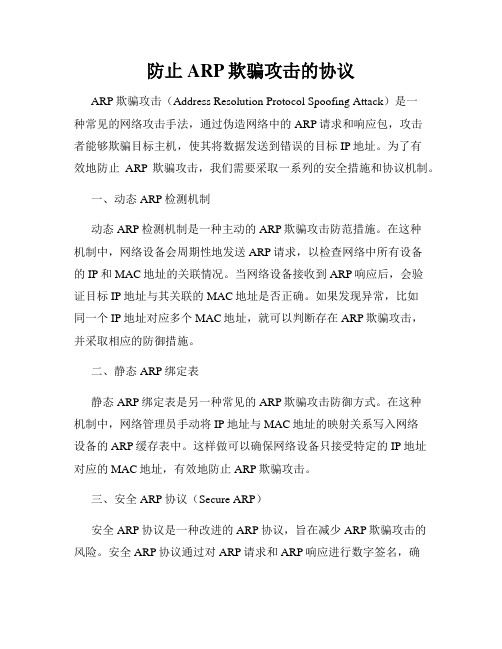
防止ARP欺骗攻击的协议ARP欺骗攻击(Address Resolution Protocol Spoofing Attack)是一种常见的网络攻击手法,通过伪造网络中的ARP请求和响应包,攻击者能够欺骗目标主机,使其将数据发送到错误的目标IP地址。
为了有效地防止ARP欺骗攻击,我们需要采取一系列的安全措施和协议机制。
一、动态ARP检测机制动态ARP检测机制是一种主动的ARP欺骗攻击防范措施。
在这种机制中,网络设备会周期性地发送ARP请求,以检查网络中所有设备的IP和MAC地址的关联情况。
当网络设备接收到ARP响应后,会验证目标IP地址与其关联的MAC地址是否正确。
如果发现异常,比如同一个IP地址对应多个MAC地址,就可以判断存在ARP欺骗攻击,并采取相应的防御措施。
二、静态ARP绑定表静态ARP绑定表是另一种常见的ARP欺骗攻击防御方式。
在这种机制中,网络管理员手动将IP地址与MAC地址的映射关系写入网络设备的ARP缓存表中。
这样做可以确保网络设备只接受特定的IP地址对应的MAC地址,有效地防止ARP欺骗攻击。
三、安全ARP协议(Secure ARP)安全ARP协议是一种改进的ARP协议,旨在减少ARP欺骗攻击的风险。
安全ARP协议通过对ARP请求和ARP响应进行数字签名,确保网络设备能够验证接收到的ARP包的合法性。
只有通过验证的ARP 包才能更新网络设备的ARP缓存表,有效地防止ARP欺骗攻击。
四、网络入侵检测系统(NIDS)网络入侵检测系统(Network Intrusion Detection System)是一种被动监测网络中异常活动的安全设备。
NIDS可以通过分析网络流量和ARP报文,检测并识别潜在的ARP欺骗攻击活动。
一旦检测到ARP 欺骗攻击行为,NIDS会发送警报,通知网络管理员采取相应的防御措施,保障网络的安全性。
五、网络安全教育和培训除了协议和技术手段外,网络安全教育和培训也是预防ARP欺骗攻击的重要环节。
arp欺骗攻击的原理
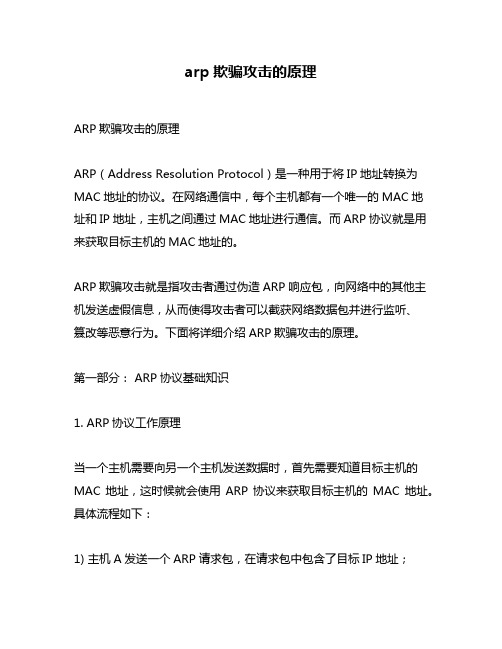
arp欺骗攻击的原理ARP欺骗攻击的原理ARP(Address Resolution Protocol)是一种用于将IP地址转换为MAC地址的协议。
在网络通信中,每个主机都有一个唯一的MAC地址和IP地址,主机之间通过MAC地址进行通信。
而ARP协议就是用来获取目标主机的MAC地址的。
ARP欺骗攻击就是指攻击者通过伪造ARP响应包,向网络中的其他主机发送虚假信息,从而使得攻击者可以截获网络数据包并进行监听、篡改等恶意行为。
下面将详细介绍ARP欺骗攻击的原理。
第一部分: ARP协议基础知识1. ARP协议工作原理当一个主机需要向另一个主机发送数据时,首先需要知道目标主机的MAC地址,这时候就会使用ARP协议来获取目标主机的MAC地址。
具体流程如下:1) 主机A发送一个ARP请求包,在请求包中包含了目标IP地址;2) 网络中所有其他主机都会接收到这个请求包;3) 目标主机B收到该请求包后,会向A发送一个ARP响应包,在响应包中携带自己的MAC地址;4) 主机A收到响应包后,就可以知道目标B的MAC地址了,并将此信息保存在本地ARP缓存中。
这样,当主机A需要向主机B发送数据时,就可以直接使用目标B的MAC地址进行通信了。
2. ARP欺骗攻击原理ARP欺骗攻击者通过伪造ARP响应包,向网络中的其他主机发送虚假信息,从而使得攻击者可以截获网络数据包并进行监听、篡改等恶意行为。
具体步骤如下:1) 攻击者首先要获取目标主机的IP地址和MAC地址;2) 攻击者伪造一个ARP响应包,将自己的MAC地址伪装成目标主机的MAC地址,并将自己的IP地址与目标主机的IP地址对应;3) 网络中其他主机收到该ARP响应包后,会将攻击者的MAC地址保存在本地ARP缓存中,并将其作为目标主机的MAC地址进行通信;4) 攻击者就可以截获网络数据包,并进行监听、篡改等恶意行为。
第二部分: ARP欺骗攻击实例分析下面以实例来分析一下ARP欺骗攻击是如何实现的。
简述arp欺骗攻击的原理和防范对策
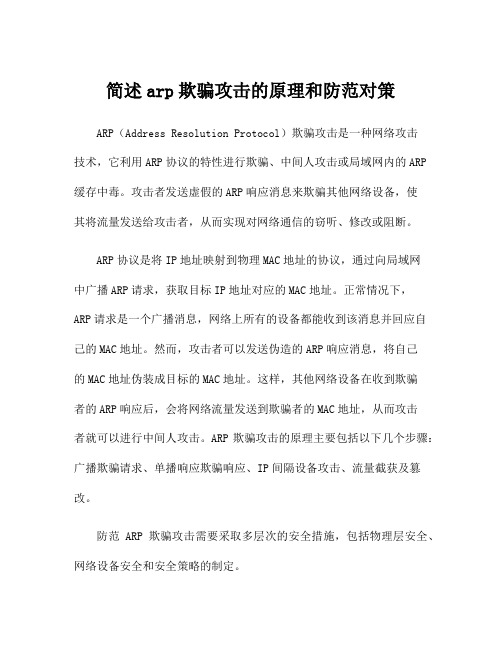
简述arp欺骗攻击的原理和防范对策ARP(Address Resolution Protocol)欺骗攻击是一种网络攻击技术,它利用ARP协议的特性进行欺骗、中间人攻击或局域网内的ARP 缓存中毒。
攻击者发送虚假的ARP响应消息来欺骗其他网络设备,使其将流量发送给攻击者,从而实现对网络通信的窃听、修改或阻断。
ARP协议是将IP地址映射到物理MAC地址的协议,通过向局域网中广播ARP请求,获取目标IP地址对应的MAC地址。
正常情况下,ARP请求是一个广播消息,网络上所有的设备都能收到该消息并回应自己的MAC地址。
然而,攻击者可以发送伪造的ARP响应消息,将自己的MAC地址伪装成目标的MAC地址。
这样,其他网络设备在收到欺骗者的ARP响应后,会将网络流量发送到欺骗者的MAC地址,从而攻击者就可以进行中间人攻击。
ARP欺骗攻击的原理主要包括以下几个步骤:广播欺骗请求、单播响应欺骗响应、IP间隔设备攻击、流量截获及篡改。
防范ARP欺骗攻击需要采取多层次的安全措施,包括物理层安全、网络设备安全和安全策略的制定。
一、物理层安全防范1.硬件设备安全:保证网络设备的物理安全,避免被攻击者直接接触或篡改网络设备。
2.网线加密:使用数字加密技术或物理加密设备,对通信网络中的网线进行加密处理,避免ARP欺骗攻击者通过在网线上截获数据。
3. MAC地址绑定:通过网络硬件设备的管理接口,将MAC地址与设备绑定,限制非法设备访问网络,避免ARP欺骗攻击者伪造MAC地址来进行攻击。
二、网络设备防范1.安全认证机制:为网络设备设置访问口令或使用其他身份验证方法,只允许授权设备进行网络操作,避免非法设备接入网络。
2. MAC地址过滤:设置ACL(Access Control List)策略,限制网络中不合法的MAC地址出现,只允许合法设备进行通信。
3. ARP缓存绑定:为网络设备的ARP缓存表添加绑定条目,将IP 地址与MAC地址进行绑定,确保只有指定的MAC地址可以响应对应的IP地址。
ARP欺骗的种类及危害
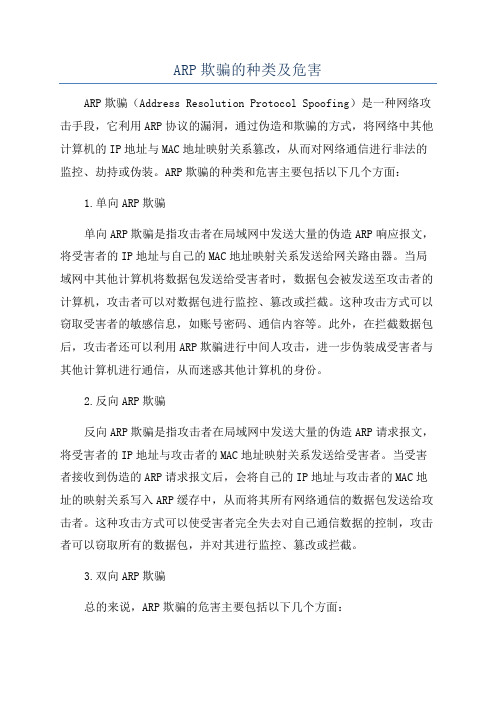
ARP欺骗的种类及危害ARP欺骗(Address Resolution Protocol Spoofing)是一种网络攻击手段,它利用ARP协议的漏洞,通过伪造和欺骗的方式,将网络中其他计算机的IP地址与MAC地址映射关系篡改,从而对网络通信进行非法的监控、劫持或伪装。
ARP欺骗的种类和危害主要包括以下几个方面:1.单向ARP欺骗单向ARP欺骗是指攻击者在局域网中发送大量的伪造ARP响应报文,将受害者的IP地址与自己的MAC地址映射关系发送给网关路由器。
当局域网中其他计算机将数据包发送给受害者时,数据包会被发送至攻击者的计算机,攻击者可以对数据包进行监控、篡改或拦截。
这种攻击方式可以窃取受害者的敏感信息,如账号密码、通信内容等。
此外,在拦截数据包后,攻击者还可以利用ARP欺骗进行中间人攻击,进一步伪装成受害者与其他计算机进行通信,从而迷惑其他计算机的身份。
2.反向ARP欺骗反向ARP欺骗是指攻击者在局域网中发送大量的伪造ARP请求报文,将受害者的IP地址与攻击者的MAC地址映射关系发送给受害者。
当受害者接收到伪造的ARP请求报文后,会将自己的IP地址与攻击者的MAC地址的映射关系写入ARP缓存中,从而将其所有网络通信的数据包发送给攻击者。
这种攻击方式可以使受害者完全失去对自己通信数据的控制,攻击者可以窃取所有的数据包,并对其进行监控、篡改或拦截。
3.双向ARP欺骗总的来说,ARP欺骗的危害主要包括以下几个方面:1.数据窃取:攻击者可以窃取通过ARP欺骗获得的数据包,包括用户的账号密码、敏感信息等。
2.数据篡改:攻击者可以对数据包进行篡改,破坏数据的完整性和可信性。
3.中间人攻击:攻击者可以利用ARP欺骗将自己伪装成通信双方之一,从而窃取双方的通信内容或者篡改通信内容。
4.拒绝服务攻击:攻击者可以通过ARP欺骗使网络中的计算机无法正常通信,从而导致网络服务的不可用。
5.传播恶意软件:攻击者可以利用ARP欺骗将受害者的数据包重定向至自己的恶意服务器上,从而传播病毒、木马等恶意软件。
arp欺骗工作原理
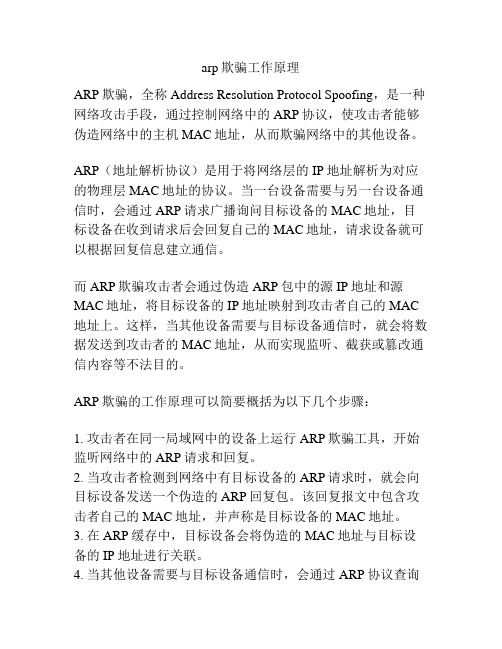
arp欺骗工作原理ARP欺骗,全称Address Resolution Protocol Spoofing,是一种网络攻击手段,通过控制网络中的ARP协议,使攻击者能够伪造网络中的主机MAC地址,从而欺骗网络中的其他设备。
ARP(地址解析协议)是用于将网络层的IP地址解析为对应的物理层MAC地址的协议。
当一台设备需要与另一台设备通信时,会通过ARP请求广播询问目标设备的MAC地址,目标设备在收到请求后会回复自己的MAC地址,请求设备就可以根据回复信息建立通信。
而ARP欺骗攻击者会通过伪造ARP包中的源IP地址和源MAC地址,将目标设备的IP地址映射到攻击者自己的MAC 地址上。
这样,当其他设备需要与目标设备通信时,就会将数据发送到攻击者的MAC地址,从而实现监听、截获或篡改通信内容等不法目的。
ARP欺骗的工作原理可以简要概括为以下几个步骤:1. 攻击者在同一局域网中的设备上运行ARP欺骗工具,开始监听网络中的ARP请求和回复。
2. 当攻击者检测到网络中有目标设备的ARP请求时,就会向目标设备发送一个伪造的ARP回复包。
该回复报文中包含攻击者自己的MAC地址,并声称是目标设备的MAC地址。
3. 在ARP缓存中,目标设备会将伪造的MAC地址与目标设备的IP地址进行关联。
4. 当其他设备需要与目标设备通信时,会通过ARP协议查询目标设备的MAC地址,但由于ARP缓存中已经被修改,请求设备会获得攻击者自己的MAC地址。
5. 请求设备将数据发送到攻击者的MAC地址,攻击者可以获得通信内容并进行进一步的操作,例如监听、截获或篡改数据。
需要注意的是,网络中的设备通常会对ARP欺骗攻击进行预防,例如使用静态ARP表、ARP防火墙、ARP监控工具等来检测并阻止这种攻击。
arp欺骗概念
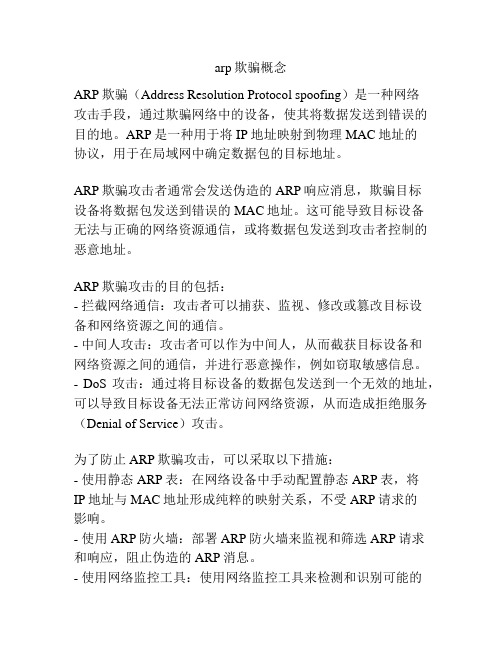
arp欺骗概念
ARP欺骗(Address Resolution Protocol spoofing)是一种网络
攻击手段,通过欺骗网络中的设备,使其将数据发送到错误的目的地。
ARP是一种用于将IP地址映射到物理MAC地址的
协议,用于在局域网中确定数据包的目标地址。
ARP欺骗攻击者通常会发送伪造的ARP响应消息,欺骗目标
设备将数据包发送到错误的MAC地址。
这可能导致目标设备
无法与正确的网络资源通信,或将数据包发送到攻击者控制的恶意地址。
ARP欺骗攻击的目的包括:
- 拦截网络通信:攻击者可以捕获、监视、修改或篡改目标设
备和网络资源之间的通信。
- 中间人攻击:攻击者可以作为中间人,从而截获目标设备和
网络资源之间的通信,并进行恶意操作,例如窃取敏感信息。
- DoS攻击:通过将目标设备的数据包发送到一个无效的地址,可以导致目标设备无法正常访问网络资源,从而造成拒绝服务(Denial of Service)攻击。
为了防止ARP欺骗攻击,可以采取以下措施:
- 使用静态ARP表:在网络设备中手动配置静态ARP表,将
IP地址与MAC地址形成纯粹的映射关系,不受ARP请求的
影响。
- 使用ARP防火墙:部署ARP防火墙来监视和筛选ARP请求
和响应,阻止伪造的ARP消息。
- 使用网络监控工具:使用网络监控工具来检测和识别可能的
ARP欺骗攻击,并采取相应的措施应对。
总之,ARP欺骗是一种利用ARP协议的漏洞,对网络安全构成威胁的攻击手段。
采取适当的防护措施可以提高网络的安全性。
ARP欺骗工具-arpspoof
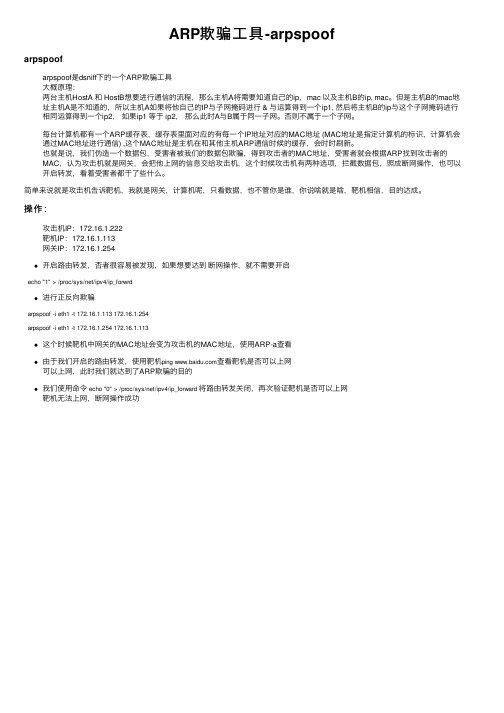
ARP欺骗⼯具-arpspoofarpspoofarpspoof是dsniff下的⼀个ARP欺骗⼯具⼤概原理:两台主机HostA 和 HostB想要进⾏通信的流程,那么主机A将需要知道⾃⼰的ip,mac 以及主机B的ip, mac。
但是主机B的mac地址主机A是不知道的,所以主机A如果将他⾃⼰的IP与⼦⽹掩码进⾏ & 与运算得到⼀个ip1, 然后将主机B的ip与这个⼦⽹掩码进⾏相同运算得到⼀个ip2,如果ip1 等于 ip2,那么此时A与B属于同⼀⼦⽹。
否则不属于⼀个⼦⽹。
每台计算机都有⼀个ARP缓存表,缓存表⾥⾯对应的有每⼀个IP地址对应的MAC地址 (MAC地址是指定计算机的标识,计算机会通过MAC地址进⾏通信) ,这个MAC地址是主机在和其他主机ARP通信时候的缓存,会时时刷新。
也就是说,我们伪造⼀个数据包,受害者被我们的数据包欺骗,得到攻击者的MAC地址,受害者就会根据ARP找到攻击者的MAC,认为攻击机就是⽹关,会把他上⽹的信息交给攻击机,这个时候攻击机有两种选项,拦截数据包,照成断⽹操作,也可以开启转发,看着受害者都⼲了些什么。
简单来说就是攻击机告诉靶机,我就是⽹关,计算机呢,只看数据,也不管你是谁,你说啥就是啥,靶机相信,⽬的达成。
操作:攻击机IP:172.16.1.222靶机IP:172.16.1.113⽹关IP:172.16.1.254开启路由转发,否者很容易被发现,如果想要达到断⽹操作,就不需要开启echo "1" > /proc/sys/net/ipv4/ip_forwrd进⾏正反向欺骗arpspoof -i eth1 -t 172.16.1.113 172.16.1.254arpspoof -i eth1 -t 172.16.1.254 172.16.1.113这个时候靶机中⽹关的MAC地址会变为攻击机的MAC地址,使⽤ARP-a查看由于我们开启的路由转发,使⽤靶机ping 查看靶机是否可以上⽹可以上⽹,此时我们就达到了ARP欺骗的⽬的我们使⽤命令echo "0" > /proc/sys/net/ipv4/ip_forward将路由转发关闭,再次验证靶机是否可以上⽹靶机⽆法上⽹,断⽹操作成功。
ARP欺骗攻击分析及防范措施

ARP欺骗攻击分析及防范措施ARP欺骗攻击(Address Resolution Protocol Spoofing Attack),也称为ARP缓存中毒攻击,是一种常见的网络攻击手段。
攻击者通过伪造ARP响应报文,将目标主机的IP地址与自己的MAC地址进行绑定,从而达到劫持网络流量、盗取敏感信息或进行中间人攻击等恶意目的。
本文将对ARP欺骗攻击进行分析,并提出相应的防范措施。
一、攻击原理分析1.ARP协议简介ARP(Address Resolution Protocol)是将IP地址与MAC地址进行匹配的协议,通过在局域网中的广播方式,发送ARP请求报文,等待目标主机响应,以获取目标主机的MAC地址。
目标主机接收到ARP请求后,会将自己的MAC地址发送给请求方,请求方在收到响应后将目标主机的IP地址与MAC地址进行绑定,并将其存储在自己的ARP缓存表中。
2.攻击原理在ARP欺骗攻击中,攻击者通过发送伪造的ARP响应报文,将目标主机的IP地址与自己的MAC地址进行绑定。
当目标主机收到该伪造的ARP响应报文后,会将攻击者的MAC地址存储到自己的ARP缓存表中。
然后,当其他主机需要与目标主机进行通信时,会将数据包发送给攻击者的MAC地址,攻击者可以拦截和篡改这些数据包,导致网络流量被劫持。
二、攻击过程分析1.发送ARP请求攻击者首先发送ARP请求报文,向网络中的所有主机请求目标主机的MAC地址。
这是一个广播的过程,所有主机都会收到该ARP请求报文。
2.伪造ARP响应目标主机收到ARP请求后,会根据请求方的IP地址将自己的MAC地址发送给请求方。
攻击者利用这个过程,伪造一个ARP响应报文,并将报文中的目标IP地址设为请求主机的IP地址,源MAC地址设为自己的MAC 地址。
3.欺骗目标主机目标主机收到伪造的ARP响应报文后,会将其中的目标IP地址与MA 地址进行绑定,并将其存储在ARP缓存表中。
此时,目标主机认为攻击者的MAC地址就是目标主机的MAC地址。
- 1、下载文档前请自行甄别文档内容的完整性,平台不提供额外的编辑、内容补充、找答案等附加服务。
- 2、"仅部分预览"的文档,不可在线预览部分如存在完整性等问题,可反馈申请退款(可完整预览的文档不适用该条件!)。
- 3、如文档侵犯您的权益,请联系客服反馈,我们会尽快为您处理(人工客服工作时间:9:00-18:30)。
外文翻译原文及译文学院计算机学院专业计算机科学与技术班级学号姓名指导教师负责教师2011年6月Detecting ARP Spoofing: An Active TechniqueVivek Ramachandran and Sukumar NandiCisco Systems, Inc., Bangalore IndiaIndian Institute of Technology, Guwahati, Assam, IndiaAbstract. The Address Resolution Protocol (ARP) due to itsstatelessness and lack of an authentication mechanism for verifyingthe identity of the sender has a long history of being prone tospoofing attacks. ARP spoofing is sometimes the starting point formore sophisticated LAN attacks like denial of service, man in themiddle and session hijacking. The current methods of detection use apassive approach, monitoring the ARP traffic and looking forinconsistencies in the Ethernet to IP address mapping. The maindrawback of the passive approach is the time lag between learningand detecting spoofing. This sometimes leads to the attack beingdiscovered long after it has been orchestrated. In this paper, wepresent an active technique to detect ARP spoofing. We inject ARPrequest and TCP SYN packets into the network to probe forinconsistencies. This technique is faster, intelligent, scalable andmore reliable in detecting attacks than the passive methods. It canalso additionally detect the real mapping of MAC to IP addresses to afair degree of accuracy in the event of an actual attack.1. IntroductionThe ARP protocol is one of the most basic but essential protocols for LAN communication. The ARP protocol is used to resolve the MAC address of a host given its IP address. This is done by sending an ARP request packet (broadcasted) on the network. The concerned host now replies back with its MAC address in an ARP reply packet (unicast). In some situations a host might broadcast its own MAC address in a special Gratuitous ARP packet. All hosts maintain an ARP cache where all address mappingslearnt from the network (dynamic entries) or configured by the administrator (static entries) are kept. The dynamic entries age out after a fixed interval of time, which varies across operating systems. After the entry ages out it is deleted from the cache and if the host wants to communicate with the same peer, another ARP request is made. The static entries never age out.The ARP protocol is stateless. Hosts will cache all ARP replies sent to them even if they had not sent an explicit ARP request for it. Even if a previous unexpired dynamic ARP entry is there in the ARP cache it will be overwritten by a newer ARP reply packet on most operating systems. All hosts blindly cache the ARP replies they receive, as they have no mechanism to authenticate their peer. This is the root problem, which leads to ARP spoofing.ARP spoofing is the process of forging ARP packets to be able to impersonate another host on the network. In the most general form of ARP spoofing the attacker sends spoofed ARP responses to the victim periodically. The period between the spoofed responses is much lesser than the ARP cache entry timeout period for the operating system running on the victim host. This will ensure that the victim host would never make an ARP request for the host whose address the attacker is impersonating. Following subsection briefly discuss the current detection and mitigation techniques.1.1 Current Mitigation and Detection TechniquesExisting ARP spoofing detection techniques are discussed next sequentially.1.1.1 Secure ARP Protocol (S-ARP)This has been proposed as a replacement for the ARP protocol in S-ARP: a Secure Address Resolution Protocol. The S-ARP protocol is definitely a permanent solution to ARP spoofing but the biggest drawback is that we will have to make changes to the network stack of all the hosts. This is not very scalable as going for a stack upgrade across all available operating systems is something both vendors and customers will not be happy about. As S-ARP uses Digital Signature Algorithm (DSA) we have the additional overhead of cryptographic calculations though the authors of the paper have claimed that this overhead is not significant.1.1.2 Static MAC EntriesAdding static MAC addresses on every host for all other hosts will not allow spoofing but is not a scalable solution at all and managing all these entries is a full time job by itself. This can fail miserably if mobile hosts such as laptops are periodically introduced into the network. Also some operating systems are known to overwrite static ARP entries if they receive Gratuitous ARP packets (GARP).1.1.3 Kernel Based PatchesKernel based patches such as Anticap and Antidote have made an attempt to protect from ARP spoofing at a individual host level. Anticap does not allow updating of the host ARP cache by an ARP reply that carries a different MAC address then the one already in the cache. This unfortunately makes it drop legal gratuitous ARP replies as well, which is a violation to the ARP protocol specification. Antidote on receiving an ARP reply whose MAC address differs from the previously cached one tries to check if the previously learnt MAC is still alive. If the previously learnt MAC is still alive then the update is rejected and the offending MAC address is added to a list of banned addresses.Both the above techniques rely on the fact that the ARP entry in the cache is the legitimate one. This creates a race situation between the attacker and the victim. If the attacker gets his spoofed ARP entry into the host’s cache before the real host can, then the real MAC address is banned. This can only be undone by administrative intervention. Thus we can conclude that wrong learning may cause these tools to fail in detecting ARP spoofing.1.1.4 Passive DetectionIn Passive Detection we sniff the ARP requests/responses on the network and construct a MAC address to IP address mapping database. If we notice a change in any of these mappings in future ARP traffic then we raise an alarm and conclude that an ARP spoofing attack is underway. The most popular tool in this category is ARPWATCH.The main drawback of the passive method is a time lag between learning the address mappings and subsequent attack detection. In a situation where the ARP spoofing began before the detection tool was started for the first time, the tool will learn the forged replies in it’s IP to MAC address mapping database. Now only after the victim starts communicating with some other host the inconsistency will be detected and an alarm rose. The attacker may have made his getaway because of this delay. Also a spoofed entry learned as in the above scenario would have to be manually undone by the networkadministrator. The only solution to this problem is to manually feed the correct address mappings into the database before starting the tool or create an attack free learning traffic. Both of these are unreasonable due to scalability and mobility issues. An ideal example would be mobile hosts e.g. laptops brought in by customers or visitors to a company. This slow learning curve makes it impossible to install passive tools on a large network (1000+ hosts) and expect them to identify attacks instantaneously.The passive techniques do not have any intelligence and blindly look for a mismatch in the ARP traffic with their learnt database tables. If an ARP spoofing is detected than there is no way of ascertaining if the newly seen address mapping is because of a spoofing attempt or the previously learnt one was actually a spoofed one. Our technique will determine the real MAC to IP mapping during an actual attack to a fair degree of accuracy.The passive learning technique is also very unreliable. A new address mapping is learnt when ARP traffic is seen from them. Thus a switch ARP Cache table overflow attempt by the generation of random ARP reply packets per second with arbitrary MAC and IP addresses will just result in new stations being discovered instead of being reported as attack traffic. To overcome problems in earlier techniques, we present a new ARP spoofing detection technique. Our technique uses an active approach to detect ARP spoofing. We send out ARP request and TCP SYN packets to probe the authenticity of the ARP traffic we see in the network. The approach is faster, intelligent, scalable and more reliable in detecting attacks than the passive methods. It can also additionally detect the real mapping of MAC to IP addresses to a fair degree of accuracy in the event of an actual attack. A description of the technique in detail is reported in following sections.2 The Proposed Active Detection Technique for ARP spoofingThe proposed technique actively interacts with the network to gauge the presence of ARP spoofing attacks. We will henceforth assume the following about the network we desire to protect.2.1 Assumptions1. The attacker’s computer has a normal network stack. This assumption will hold for most of the attacks as “ready to use” ARP spoofing tools have always been the attacker’s most popular choice. If the attacker does use a customized stack then our technique willstill detect ARP spoofing but will not be able to predict the correct address mappings anymore. We will discuss performance in the presence of a customized stack in section 2.5.2. The individual hosts we desire to protect on the network may use a personal firewall but at least one TCP port should be allowed through the firewall. This is to allow our probe packets (TCP SYN packets) to go through. This is a reasonable assumption as even if a firewall is installed some LAN based services such as NETBIOS etc are normally allowed through it for LAN communication.3. We assume that all devices, which we protect, have a TCP/IP network stack up and running.2.2 TerminologyWe now introduce the terminology used in the rest of this paper.1. Threshold interval: ARP replies to an ARP request must be received within a specified time interval. After this time has elapsed we will consider the ARP request to have “expired”.We will call this interval as the “Threshold Interval”. This will be administratively configurable on any tool using our technique.2. Host Database: This is the mapping of all legitimate IP and MAC pairs on the network verified and learnt by our technique.The ARP packets consist of the MAC header and the ARP header. Based on the value of the source and destination MAC addresses in the MAC header and as advertised in the ARP header we can divide the all ARP packets into 2 categories.1. Inconsistent Header ARP packets: The MAC addresses in the MAC and ARP header differ i.e. Source MAC address in MAC header! = Source MAC address in ARP header (in ARP requests/responses) and/or Destination MAC address in MAC header! = Destination address in ARP header (only for ARP replies).2. Consistent Header ARP packets: These are the compliment of the Inconsistent Header ARP packets. The MAC addresses in the MAC and ARP headers match in these packets.Note that Inconsistent Header ARP packets are guaranteed spoofed packets as such an anomaly is only possible in attack traffic. Based on the above classification we can further bunch the Consistent Header ARP packets into three groups:1. Full ARP Cycle: An ARP request and its corresponding ARP replies seen within the threshold interval.2. Request Half Cycle: An ARP request for which no replies are sent as seen within the threshold time.3. Response Half Cycle: An ARP reply generated without an ARP request. These three categories form the basis of our input to the ARP spoofing detection mechanism. The following subsection discusses the Architecture of the proposed technique in detail.2.3 ArchitecturePlease refer to Figure 1 for the architecture discussion. We have adopted a modularized approach and have divided our spoof detection into the following modules:1. ARP Sniffer module: This sniffs all ARP traffic from the network.2. MAC - ARP header anomaly detector module: This module classifies the ARP traffic into Inconsistent Header ARP packets and Consistent Header ARP packets.3. Known Traffic Filter module: This filters all the traffic, which is already learnt. It will either drop the packet if the IP to MAC mapping is coherent with the learnt Host Database or raise an alarm if there are any contradictions. All the new ARP packets with unknown addresses are sent to the Spoof Detection Engine for verification.4. Spoof Detection Engine module: This is the main detection engine. We feed the Consistent Header ARP packets to it as input. The design of this module will be discussed in Section 2.4.5. Add to Database Module: Legitimate ARP entries verified by the Spoof Detection Engine are added to the Host Database by this module.6. Spoof Alarm Module: This module raises an alarm on detection of ARP spoofing by sending a mail, SMS etc to the administrator.Fig. 1. Inter-relation between various Modules used by the ARP Spoof Detection AlgorithmAs shown in Figure 1, the ARP Sniffer module sniffs all the ARP traffic in its LAN segment and passes it to the MAC – ARP Header Anomaly Detector. This module passes the entire Consistent Header ARP packets to the Known Traffic Filter module. The entireInconsistent Header ARP packets are sent to the Spoof Alarm. This is done because the Inconsistent Header ARP packets are all spoofed packets as discussed earlier. The Known Traffic Filter module will remove all traffic coherent with the already learnt addresses by consulting the Host Database. If there is a contradiction in the ARP traffic for already learnt addresses then it raises a Spoof Alarm. All new ARP traffic is passed to the Spoof Detection Engine.The Spoof Detection Engine applies our detection algorithm to detect ARP spoofing. The newly seen Consistent Header ARP packets are input to this module. The engine now internally bunches these packets into the three categories discussed in Section 2.2 namely Full ARP Cycle, Request and Response Half Cycle packets. The detection algorithm applied by the engine will be discussed in the section 2.4. After applying the detection algorithm the Spoof Detection engine either sends the ARP entry to the Add to Database module or the Spoof Alarm module. The Add to Database module will add these verified MAC and IP address mapping to the Host Database. The spoof detection engine is discussed in detail next.2.4 The Spoof Detection EngineThe Spoof Detection Engine is the heart of the whole system. The three different ARP Cycle packets as discussed in Section 2.2 are treated in slightly different ways by the Spoof Detection Engine to detect an attempted spoofing. The Spoof Detection Engine works based on the following Rules:Rule A: “The network interface card of a host will accept packets sent to its MAC address, Broadcast address and subscribed multicast addresses. It will pass on these packets to the IP layer. The IP layer will only accept IP packets addressed to its IP address(s) and will silently discard the rest of the packets. If the accepted packet is a TCP packet it is passed on to the TCP layer. If a TCP SYN packet is received then the host will either respond back with a TCP SYN/ACK packet if the destination port is open or with a TCP RST packet if the port is closed”.Rule B: “The attacker can spoof ARP packets imp ersonating a host but he can never stop the real host from replying to ARP requests (or any other packet) sent to it. The valid assumption here is that the r eal host is up on the network.”It should be noted that these rules have been derived from the correct behavior that a host’s network stack should exhibit when it receives a packet. To exemplify Rule A, let a host have MAC address = X and IP address = Y. If this host receives a packet with destination MAC address = X and destination IP address = Z then even though the network interface card would accept the packet as the destination MAC address matches, the host’s network stack will silently discard this packet as the destination IP address does not match, without sending any error messages back to the source of the packet.Based on Rule A, we can conceive of two types of probe packets from a host’s network stack point of view which we will use to detect ARP spoofing.a. Right MAC – Wrong IP packet: The destination MAC address in the packet is of the hos t but the IP address is invalid and does not correspond to any of the host’s addresses. The destination host will silently drop this packet.b. Right MAC – Right IP packet: The destination MAC address and IP addresses pairs are of the host’s and its networ k stack accepts it.We will henceforth assume that the attacker is using an unmodified network stack. The performance of our technique in the presence of a modified network stack will be evaluated in Section 2.5. Based on the above observation we will construct our own packets based on Rule A and send them on the network. We will use the address information in the ARP response packet sent by the host whose authenticity is to be verified. We will use the MAC and IP addresses used in the ARP response packet to construct a TCP SYN packet i.e. the destination MAC and IP in the TCP SYN packet will be the source MAC and IP address advertised in the ARP response packet and the source MAC and IP in the TCP SYN packet would be of the host running the Spoof Detection Engine. The TCP destination port will be chosen based on the presence/absence of packet filtering firewalls on the network hosts. If there is a firewall installed on the hosts we will choose the “allowed TCP port” (as in section 2.1) and if no firewalls ar e there then we can choose any TCP port. The rest of the header values in the TCP SYN packet will be set as usual.When a TCP SYN packet as constructed above is sent to the source of the ARP reply packet, the host’s response will be based on Rule A. If the ARP response was from the real host its IP stack will respond back with either a TCP RST packet (If the destination port is closed) or a TCP SYN/ACK packet (if the destination port is open).If the ARP response had been from a malicious host then its network stack would silently discard the TCP SYN packet in accordance with Rule A. Thus based on the fact that the Spoof Detection Engine does/does not receive any TCP packets in return to the SYN packet it sent, it can judge the authenticity of the received ARP response packet.APR欺骗检测:一种主动技术手段维克拉玛苍兰和舒库玛南迪思科系统公司班加罗尔印度印度理工学院,古瓦哈蒂,阿萨姆,印度摘要.地址解析协议(ARP)由于其无状态性和缺乏对发送者身份进行验证的机制,因而长久以来常被用于欺骗攻击。
